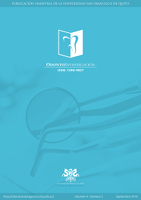In vitro comparison of corono-apical microleakage of Enterococcus faecalis using three different filling techniques: lateral, vertical and gutta-percha carrier-based, in single-root premolars
Main Article Content
Abstract
The purpose of this study was to compare leakage of Enterococcus faecalis in three filling techniques: lateral condensation, vertical condensation and gutta-percha carrier-based obturation. Forty single-root premolars were decoronated and prepared until Reciproc R50.
A modified Torabinejad model was used consisting of a split chamber where E. faecalis was placed in the upper chamber could reach the lower chamber only through the filled canal. The Kruskal-Wallis test showed that core-carrier gutta-percha obturation and vertical obturation groups were statistically superior to lateral obturation group. No statistically significant difference was found between the lateral obturation and positive control, nor between core-carrier technique and vertical obturation (p > 0.05). In conclusion, core-carrier gutta-percha obturation group showed greater resistance to filtration of E. faecalis but it was not statistically superior to vertical condensation group.
Article Details
References
Hammad, M; Qualtrough, A y Silikas, N. Evaluation of Root Canal Obturation: A Three-dimensional In Vitro Study. Journal of Endodontics.2009; 35(4):541-544.
Goldberg, F; Artaza, L.P y De Silvio, A. Effectiveness of Different Obturation Techniques in the Filling of Simulated Lateral Canals. Journal of Endodontics.2001; 27(5):362-364.
Prado, M; Simao, R.A y Gomes, B.P. A microleakage study of gutta-percha/AH Plus and Resilon/Real self-etch systems after different irrigation protocols. Journal of Applied Oral Science. 2014; 22(3):174-179.
Schäfer, E. y Olthoff, G. Effect of three different sealers on the sealing ability of both Thermafil obturators and cold laterally compacted gutta-percha. Journal of Endodontics.2002; 28(9):638-642.
Perry, C; Kulild, J.C y Walker, M.P. Comparison of Warm Vertical Compaction Protocols to Obturate Artificially Created Defects in the Apical One-third. Journal of Endodontics. 2013; 39(9):1176-1178.
Schäfer, E; Kester, M. y Bürklein, S. Percentage of Gutta-percha-filled areas in canals instrumented with nickel-titanium systems and obtrude with matching single cones. Journal of Endodontics. 2013; 39(7):924-928.
Hedge, V y Arora, S. Effect of advanced irrigation protocols on self-expanding Smart-Seal obturation system: A scanning electron microscopic push-out bond strength study. Contemporary Cinical Dentistry. 2015; 6(1):26-30.
Zoletti, G.O; Siqueira, J.F. y Santos, K.R.N. Identification of Enterococcus faecalis in root-filled teeth with or without perirradicular lesion by culture dependent and - independent approaches. Journal of Endodontics.2006; 32(8):722-726.
Whitten, R. y Leviton, M. The effect of canal preparation on fill length in straight root canals obdurate with GuttaCore. Journal of Endodontics.2015; 41(2):155-158.
VDW. Instrucciones de uso BeeFill 2in1. Estados Unidos; 2014
Torabinejad, M; Ung, Borasmy y Kettering, J. In Vitro Bacterial Penetration of Coronally Unsealed Endodontically Treated Teeth. Journal of Endodontics.1990; 16(12): 566-569.
Martínez, P; Gómez, M; Felií, K; Alcántar, R y Fuentealba, P. Estudio comparativo de microfiltración apical entre tres técnicas de obturación radicular: Calamus, Guttacore y Guttafusion. Resumen del Congreso de la Sociedad Endodoncia Concepción. 2017; 8-9.
Shipper, G; Ørstavik, D; Batista, F y Trope, M. An Evaluation of Microbial Leakage in Roots Filled with a Thermoplastic Synthetic Polymer-Based Root Canal Filling Material (Epsilon). Journal of Endodontic.2004; 30(5):342-347.
Castañeda, A; Hernández, S; Robles, J; Velázquez, J; Benitez, C y Barajas, L. Estudio comparativo de filtración apical entre las técnicas de obturación lateral y vertical en endodoncia. Revista Oral. 2010; 11(33): 573-576.
Miranda, J; Franco, C; Vásquez, B; Fente, C; Barros-Velázquez; J y Cepeda, A. Evaluation of Chromocult enterococci agar for the isolation and selective enumeration of Enterococcus spp in broiler. Letters in Applied Microbiology. 2005; 41: 153-156.
Colán, P. y García, C. Microfiltración apical in vitro de tres cementos utilizados en la obturación de conductos radiculares. Rev Estomatol Herediana. 2008; 18(1):9-15.
De Sousa, B; Koury, J; García, E; Méndez, C y Antúnez, M. Interfase TopSeal-dentina en relación con dos técnicas de obturación: Condensación lateral y técnica termoplastificada/ termoreblandecida. Estudio de microscopía electrónica de barrido. Universitas Odontológica. 2010; 29(62):39-44.
Ponce, A; Izquierdo, J.C. Sandoval, F. y De Los Reyes, J.C. Estudio comparativo de filtración apical entre la técnica de compactación lateral en frío y técnica de obturación con System B. Revista Odontológica Mexicana.2005; 9(2):65-72.
Gençoglu N1, Oruçoglu H, Helvacioglu D. Apical leakage of different gutta-percha Techniques: Thermafil, Js Quick-Fill, Soft Core, Microseal, System B and Lateral Condensation with a Computerized Fluid Filtration Meter. European Journal of Dentistry. 2007; 1(2):97-103
Tomer, A; Banerjee, S; Bhardwaj, G; Malik, N; Muni, S y Rana, S. Comparative Evaluation of Apical Microleakage of Various Obturation Techniques using Single Cone Gutta-percha, Lateral Condensation, Obtura, Calamus and Thermafil by Dye Penetration Method. International Journal of Oral Care and Research. 2016; 4(1): 4-7.
Briseño, B; Gerhard, T; Schürger, D. y Willershausen, B. Thermoplastic properties of Endodontic gutta-percha: A thermographic In Vitro Study. Journal of Endodontics. 2015; 41(1):79-82.
Giudice, A. Y Torres, J. Obturación en endodoncia - Nuevos sistemas de obturación: revisión de literatura. Revista Estomatológica Herediana. 2011; 21(3):166-174.

